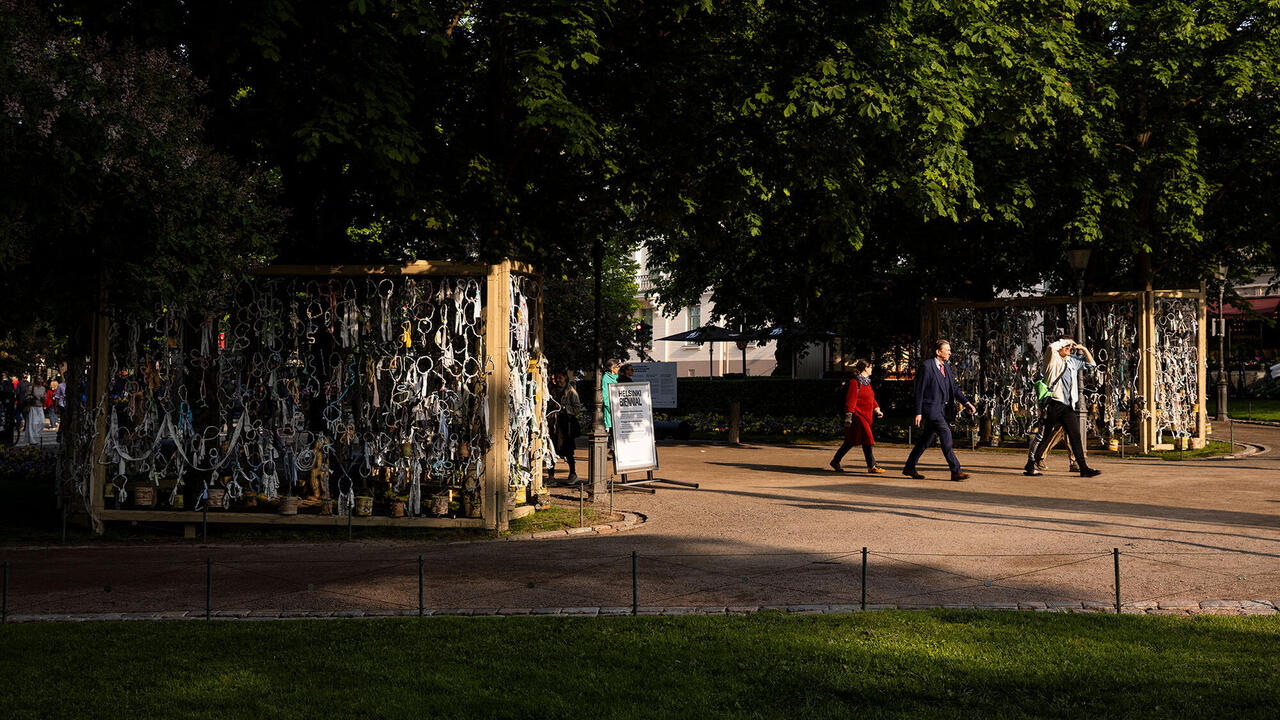TeidenEXPO
For those who saw it, the two-night run of the TeidenEXPO (Blackout Expo) performance was one of the highlights of the opening weekend of the recently launched International Festival for Arts and Media Yokohama 2009. Conceived by a group of young artists and dancers – Tetsuya Umeda, Megumi Kamimura, Neji Pijin, Kanta Horio and a collective named 'contact Gonzo' – the performance took the form of an absurdist initiation rite, generating a communal experience of the humour and violence that underpin communal interactions.

The performance was staged in dead space surrounding a freestanding cube-shaped theatre that had been constructed in the centre of the expansive Shinko Pier warehouse, one of the festival’s main venues. Concentrated on one side of the rectilinear circuit surrounding the theatre was an installation of odd props that served as an initial backdrop to the action: old electric fans, a 30-foot black vinyl ‘bell’ suspended from the ceiling, a ladder, cardboard boxes, a rusted station clock face and a mobile of hoses and plastic jerry cans hovering over a gigantic basin filled with pink fluid.

Upon entering, audience members sat on the floor facing the installation with their backs against an exterior wall of the theatre as the artists continued shifting the props. Suddenly, additional performers emerged from within the audience and began walking around the installation with their eyes closed. The artists assumed the role of caretakers, handing props to the ‘blind people’ and pushing them in different directions. As the blind moved around, they bumped into each other or tripped over audience members, creating fleeting comic incidents that gradually took on an air of pathos and then a zombie-like stupid malevolence. The artists, growing ever more imposing in their interactions with the blind, began to engage in a play jiujitsu among themselves. This jiujitsu became increasingly violent, evolving into slaps, punches and body-slams while the zombies continued shuffling throughout the entire circuit, moving in and out of the audience’s sight.

Eventually, audience members began circulating the space to follow the action occurring on the other side of the theatre, which, with doors on two of its opposing sides, was itself opened to traffic. At some point, the performers were allowed to open their eyes and – at regular intervals – raced from one side of the circuit to the other, then lay down and played dead. The overhead lights cut out and the entire space was illuminated only by flickering light bulbs strung from the ceiling. Shuffling from one place to another, the audience members themselves began to resemble zombies. It was impossible to tell who was a performer or not, and there was a palpable sense of danger as the caretakers’ jiujitsu spun further out of control while the ex-zombies continued their racing.

Considering that the theme of the festival was ‘Deep Images’, this anarchic performance suggested a composition of anti-images. With the performers atomized across the entire staging area, there was never any ‘scene’ to document, nor any defining narrative framework. The audience would converge to where they thought the action was happening, only to realize that the action was elsewhere. At one point, the theatre seating was almost full but there were no actual performers in the theatre. Watching the audience itself atomize and then regroup provided insight into how a reliance on a consensus focal point (the rubber-necking or herd instinct) can be entirely arbitrary.
In place of meaning, one was left with a series of subjective, fleeting impressions: the sight of the massive vinyl bell billowing in the darkness as it was blown by an electric fan; the freeze-frame of twisting bodies caught in a camera flash; the sounds of slaps, popping balloons and smashed bulbs. This combination of nihilism and social critique recalled Japanese forebears ranging from postwar Butoh to the 1980s and ‘90s works of the multi-disciplinary group dumb type, which also combined performance and installation art. But in its literal and figurative inversion of the architecture of spectacle, TeidenEXPO succeeded in articulating an idiom that was unique to a specific place, time and viewpoint – a remarkable feat in the current age of information.















